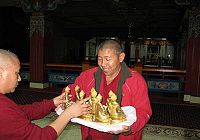Gelug
From Buddha World
The Gelug or Gelug-pa, also known as the Yellow Hat sect, is a school of Buddhism founded by Tsongkhapa (1357–1419), a philosopher and Tibetan religious leader. The first monastery he established was at Ganden, and to this day the Ganden Tripa is the nominal head of the school, though its most influential figure is the Dalai Lama.
Lama Tsongkhapa
A great admirer of the Kadampa (Bka'-gdams-pa) teachings, Tsongkhapa was an enthusiastic promoter of the Kadam School's emphasis on the Mahayana principles of universal compassion as the fundamental spiritual orientation. He combined this with a strong emphasis on the cultivation of in-depth insight into the doctrine of emptiness as propounded by the Indian masters Nagarjuna (2nd century) and Candrakirti (7th century). Tsongkhapa said that these two aspects of the spiritual path, compassion and insight into wisdom, must be rooted in a wholehearted wish for liberation, all impelled by a genuine sense of renunciation. He called these the "Three Principal Aspects of the Path", and suggested that it is on the basis of these three that one must embark on the profound path of Vajrayana Buddhism. The central teachings of the Gelug School are Lamrim, or the "Stages of the Path", based on the teachings of the Indian master Atisha (circa 11th century) and the systematic cultivation of the view of emptiness. This is combined with the deity yogas of Highest Yoga Tantra deities such as Guhyasamaja, Cakrasamvara, Yamantaka and Kalacakra, where the key focus is the realization of the indivisible union of bliss and emptiness. Six scriptures by Tsongkhapa are the prime source for the studies of the Gelug tradition, as follows:
- The Great Exposition of the Stages of the Path (Lam-rim chen-mo),
- The Great Exposition of Tantras (sNgag-rim chenmo),
- The Essence of Eloquence on the Interpretive and Definitive Teachings (Drnng-nges legs-bshad snying-po),
- The Praise of Relativity (rTen-'brel bstodpa),
- The Clear Exposition of the Five Stages of Guhyasamaja (gSang-'dus rim-lnga gsal-sgron) and
- The Golden Rosary (gSer-phreng).
Each Gelug monastery uses its own set of commentarial texts by different authors, known as monastic manuals (Tib. yigcha). The teachings of Tsongkhapa are seen as a protection against misconceptions in Mahayana and Vajrayana Buddhism. It is said that his followers take The Great Exposition of the Stages of the Path as their heart teaching. The Gelug school has placed Vinaya ethics and monastic discipline as the central plank of spiritual practice. In particular, the need to pursue spiritual practice in a graded/sequential manner is emphasized. Arguably, Gelug is the only school of Vajrayana Buddhism that prescribes monastic ordination as a necessary qualification and basis in its teachers (lamas / gurus). Lay people are usually not permitted to give initiations if there are teachers with monastic vows within close proximity. This discipline was laid down by Tsongkhapa as a mechanism to prevent Buddhist teachings from further degenerating. One of the profound (but not necessarily distinguishing) features of the Gelug tradition is that it teaches the outward calm and controlled demeanour of the hearer, whilst at the same time the internal poise associated with the two stages of the yogic practitioner. Tsongkhapa's explanation adopts both Sutra and Tantra as mutually complementary paths.
Monasteries and Lineage Holders
Tsongkhapa founded the monastery of Ganden in 1409, and it became his main seat. He had many students, his two main disciples being Gyaltsab Je (1364–1431) and Khedrub Je (1385–1438). Other outstanding disciples were Togden Jampal Gyatso, Jamyang Choje, Jamchenpa Sherap Senge and Gyalwa Gendün Drup, the first Dalai Lama (1391–1474). After Tsongkhapa's passing, his teachings were held and kept by Gyaltsab Je and Khedrub Je who were the next abbots of Ganden monastery. The lineage has been held by the Ganden Tripas – the throne-holders of Ganden Monastery – among whom the present holder is Khensur Lungri Namgyal, the 101st Ganden Tripa (and not, as is often misunderstood, the Dalai Lama). Drepung Monastery was founded by Jamyang Choje, Sera Monastery was founded by Chöje Shakya Yeshe and the Gyalwa Gendün Drup founded Tashi Lhunpo Monastery. Labrang Monastery, in Xiahe County in Gansu province (and in the traditional Tibetan province of Amdo), was founded in 1709 by the first Jamyang Zhaypa, Ngawang Tsondru. Many Gelug monasteries were built throughout Tibet as well as in China and Mongolia. Among the many lineage holders of the Gelug are the successive incarnations of the Dalai Lama (also known as Gyalwa Rinpoche), the succession of the Panchen Lama, the Chagkya Dorje Chang, Ngachen Könchok Gyaltsen, Kyishö Tulku Tenzin Thrinly, Jamyang Shepa, Phurchok Jampa Rinpoche, Jamyang Dewe Dorje, Takphu Rinpoche, Khachen Yeshe Gyaltsen, and many others.
Vajrayana Practice in the Gelug
Guhyasamaja, Chakrasamvara and Yamantaka are the three principle yidam practices in the Gelug lineage, although Kalachakra practice is also important. Guhyasamaja is the principle one, as the Dalai Lama notes, "there is a saying in the Gelug, 'If one is on the move it is Guhyasamaja. If one is still, it is Guhyasamaja. If one is meditating, it should be upon Guhyasamaja.’ Therefore, whether one is engaged in study or practice, Guhyasamaja should be one’s focus."
Influence
By the end of 16th century, following strife among the sects of Tibetan Buddhism, the Gelug school emerged as the dominant school. From the period of "The Great Fifth" in the 17th century until the Chinese takeover in 1949, the Dalai Lamas held political control over central Tibet. In the course of this reign, the Jonang school was forcibly converted to the Gelug tradition, along with many Kagyu and Nyingma monasteries.

 Русский
Русский
